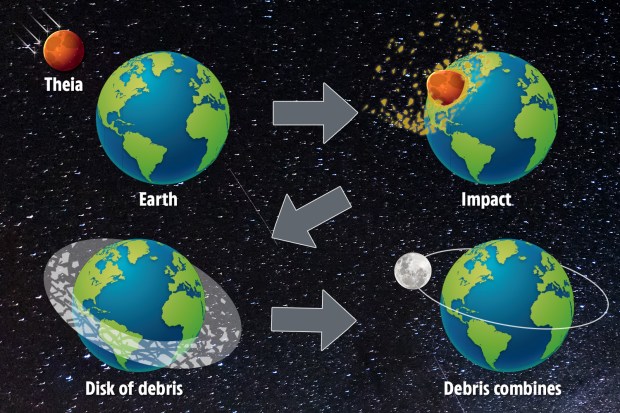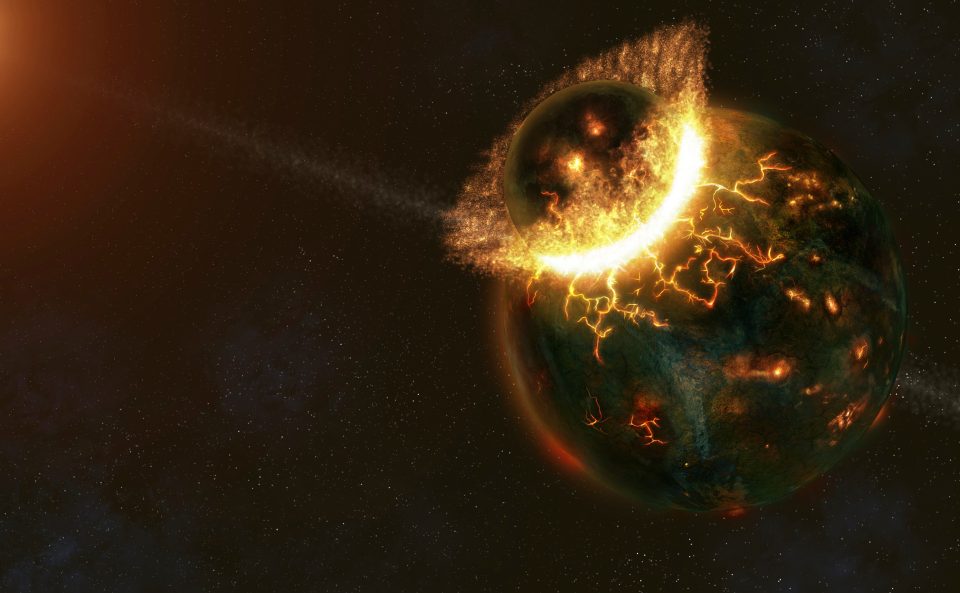Scientists prove how Moon was formed after finding chunk of doomed planet that smashed into Earth in its core

SCIENTISTS think they've found a 'chunk' of the doomed planet suspected of creating the Moon underneath the lunar surface.
One theory for the creation of the Moon is that a large planet crashed into Earth 4.5 billion years ago and debris that fell from our planet became the Moon.
The impacting planet, referred to as Theia, is thought to have fused with Earth but scientists think they've now found a 'chunk' of it buried deep under the lunar surface.
The Theia impact, also referred to as the giant impact or the 'big splash', is a hypothesis which suggests that the Moon was formed from debris that was broken off Earth when a giant planet sized object collided with it.
This planet sized object is known as Theia and is often described as an 'ancient planet' that was the size of Mars.
Analysis of Moon rocks has suggested that the impact was one direct hit and the Moon could actually be a combination of a chunk of Earth and parts of Theia.
For the first time ever, scientists believe they've found traces of Theia on the Moon which could confirm the favoured model for explaining its formation.
The researchers, from the University of New Mexico, wrote in their paper: "This model was capable of accounting for the then-recent observations from samples returned by the Apollo missions.
"Which included the Moon's low iron content relative to Earth, depletion in volatiles and enrichment in refractory elements, while avoiding most of the pitfalls of previous lunar origin theories."
The study required an intricate look into the makeup on the Moon and revealed that it's more different to Earth than previously thought.
Previous computer models of the impact have suggested that 70-90% of the Moon should be material from Theia.
Other's suggest the Moon should be similar to Earth.
This should be easy to determine as most bodies in the Solar System have their own chemical makeups that can be differentiated from one another.
The researchers intensely analysed the Moon rock samples and found small differences in the isotopes that make up the Moon and Earth.
Study lead author Erick Cano, a stable-isotope geochemist at the University of New Mexico, : "Going into this project, it was expected that our results would likely mirror that of previous studies.
"The most surprising part of our results was finding the amount of variation that we did between the individual lunar samples."
The variation in all samples suggested that the deeper into the Moon's surface, the more similar the Moon becomes to Theia than Earth.
The researchers wrote in their study: "Our data suggest that samples derived from the deep lunar mantle, which are isotopically heavy compared to Earth, have isotopic compositions that are most representative of the proto-lunar impactor ‘Theia’."
The researchers now support the idea that the Theia collision led to mixing between the Mars-sized planet and Earth.
They think this mixing led to the similar but distinct compositions of Earth and the Moon.
Scientists eagerly await new Moon rock samples so that theories like this can be tested further.
This research has been published in the journal .
The Moon – our closest neighbour explained
Here's what you need to know...
- The Moon is a natural satellite – a space-faring body that orbits a planet
- It's Earth's only natural satellite, and is the fifth biggest in the Solar System
- The Moon measures 2,158 miles across, roughly 0.27 times the diameter of Earth
- Temperatures on the Moon range from minus 173 degrees Celcius to 260 degrees Celcius
- Experts assumed the Moon was another planet, until Nicolaus Copernicus outlined his theory about our Solar System in 1543
- It was eventually assigned to a "class" after Galileo discovered four moons orbiting Jupiter in 1610
- The Moon is believed to have formed around 4.51billion years ago
- The strength of its gravitational field is about a sixth of Earth's gravity
- Earth and the Moon have "synchronous rotation", which means we always see the same side of the Moon – hence the phrase "dark side of the Moon"
- The Moon's surface is actually dark, but appears bright in the sky due to its reflective ground
- During a solar eclipse, the Moon covers the Sun almost completely. Both objects appear a similar size in the sky because the Sun is both 400 times larger and farther
- The first spacecraft to reach the Moon was in 1959, as part of the Soviet Union's Lunar program
- The first manned orbital mission was Nasa's Apollo 8 in 1968
- And the first manned lunar landing was in 1969, as part of the Apollo 11 mission
TOP STORIES IN SCIENCE
In other space news, a huge space contraption is gearing up to scan alien atmospheres and peer back to the dawn of time.
Nasa's Mars 2020 rover has officially been named Perseverance and will be blasted off to space in July.
And, the most detailed panorama ever snapped from the surface of Mars has been unveiled by Nasa.
What do you think of the Theia collision hypothesis? Let us know in the comments...
We pay for your stories! Do you have a story for The Sun Online Tech & Science team? Email us at tech@the-sun.co.uk














